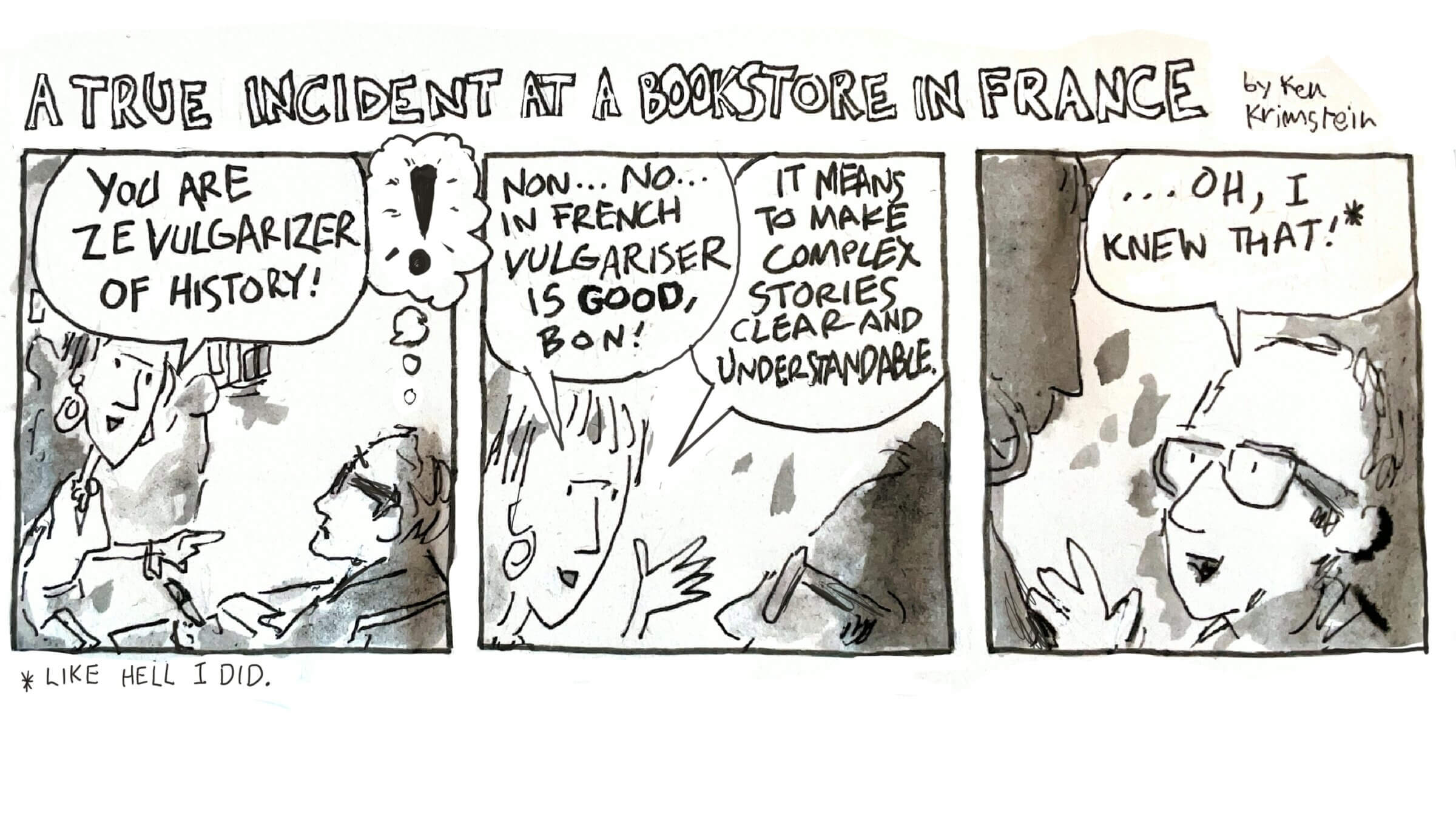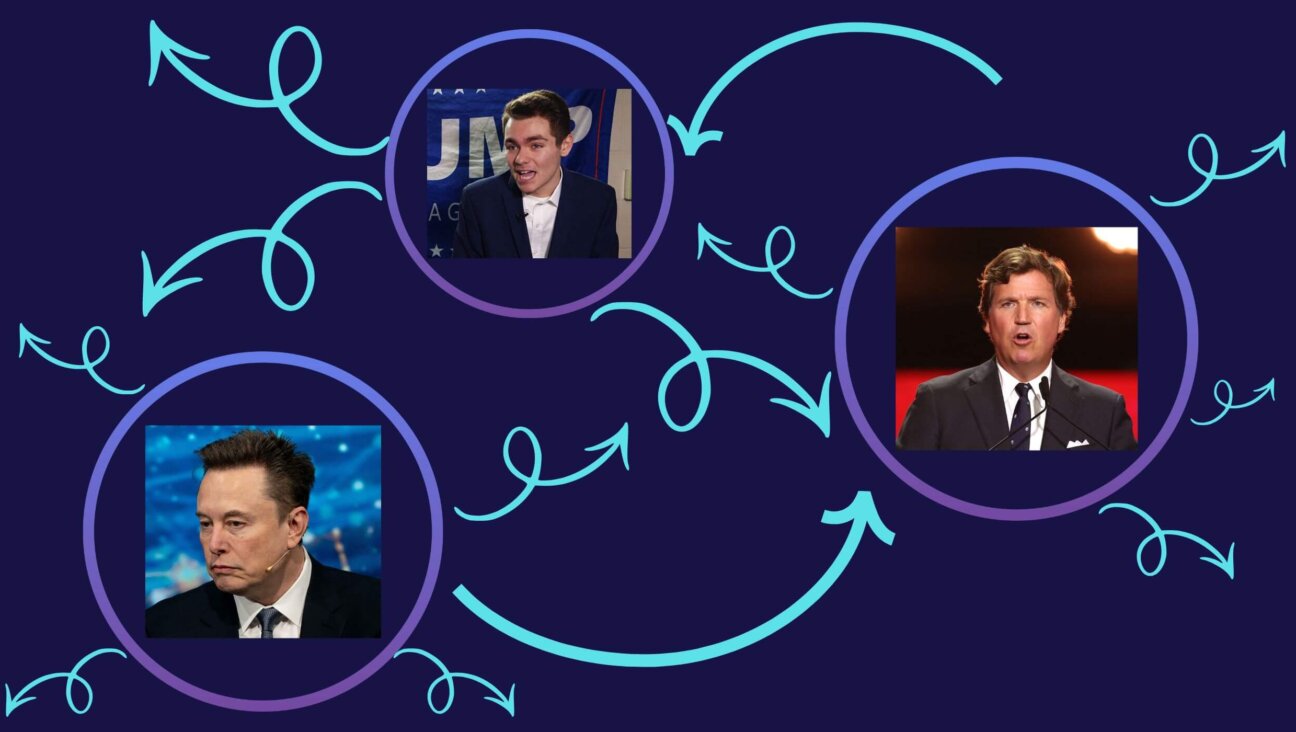How I became a vulgarizer — and why you should become one too
For an author of graphic narratives, vulgarizing is the point, not a criticism

In France, Ken Krimsten learned what it means to be a vulgarizer. Graphic by Ken Krimstein
After a recent reading of one of my nonfiction graphic narratives, a French woman came up to me and called me a vulgarizer of history. In response to my jaw drop, she explained that she was offering me a compliment, not an insult. “You see,” she said, “in French, to vulgarize is a good thing.”
I couldn’t believe my ears, so I checked out the Cambridge French-English Dictionary on my phone and lo and behold, up came the following:
Vulgariser: verb [transitive]; rendre compréhensible par tous, to bring within everyone’s reach. For example: vulgariser la science, to bring science within everyone’s reach.
Instead of accusing me of making things common or ugly, she was telling me I was making the complicated easy to understand. Accessible, even enjoyable.
After years of struggling to define what I do, I knew at last. Je suis un vulgarisateur de l’histoire. I make the complex easy to engage with and understand. I use the form of graphic nonfiction narrative or nonfiction comics or — to use the French phrase for this bastard medium — bandes dessinées (“strips of drawings,” often styled as BD and pronounced “bay day” in French) to transport people to the past and the future.
Now, aside from possibly providing an answer for trivia night at your local pub, why is any of this remotely relevant? Or as my professor Don Schultz at Northwestern would have put it, “Who cares?”
You should. Not just because the specialists have taken over and it’s the duty of an educated public to understand what’s what and who’s who and how’s how, but because the loudest, most bellicose voices — not to mention those of the thinking robots who may very well want to lead us into a thoroughly inhuman, inhumane existence — are squeezing out the sensible voices. The result of all this noise, for you, is a sea of un-understanding, division, and, to cut to the chase, ignorance. Or to be even more precise, stupidity.
Not that I’m an Einstein (although incidentally, I just published a nonfiction BD vulgarizing Einstein’s path to “the greatest achievement of pure thought in human history”), but as a cartoonist, writer, historian, and yes, advertising creative director and university professor, I have discovered that you can’t confuse people into learning. You can’t insult, browbeat, intimidate, or mechanize them into getting smart about the past. No, you must cajole, even entertain them.
See, the word “history” itself sends most people running for the hills. History: Dead people, old buildings, dates and places. Zzzzzzzz. But vulgarized history? Surprises, invitations, challenges, subversion of cliché!
In my days as an advertising creative director and professor, I came to worship these sage words of ad guru Howard Gossage: “People don’t read ads, people read what’s interesting — and sometimes it’s an ad.” When I became a writer and graphic storyteller, I stole Gossage’s maxim, switched the word “ads” for “history,” and there you go: my secret laid bare.
We must tell better stories. Or to quote Hannah Arendt (whose life and thought I vulgarized in my first nonfiction BD, The Three Escapes of Hannah Arendt — A Tyranny of Truth), “Storytelling reveals meaning without committing the error of defining it.” Rephrased as advice for the BD creator, use pictures and words to amplify the connection between the reader and history as a life lived.
I’m not the only person working in nonfiction storytelling these days who gets the power of vulgarisation. The immensely popular podcast, The Rest Is History, has achieved Brobdingnagian stature among the masses despite discussing arcane details of the demise of the Austro-Hungarian Empire, what kind of tea Admiral Horatio Nelson’s father favored, and how, in the musical Hamilton, the founding father’s travails had people of all ages, races, faiths, and gender identities literally dancing in the aisles to the strains of The Federalist Papers. Who among us hasn’t cheered Ken Burns’ photo collages as we travel in his unique time machine to the early years of baseball or Leonardo da Vinci’s school days?
Vulgarizers one and all. More fundamentally, these are examples of people talking to people about people — seducing them, storytelling them, vulgarizing them into the dangerous, scary, unpredictable act of thinking for themselves. Not by giving answers, but by helping readers ask better questions as a prelude to thinking for themselves.
Why is this dangerous? Because once people start thinking, well, who knows what they might think? Or make? Or do? To summon another insight from Hannah Arendt, “There are no dangerous thoughts — thinking itself is a dangerous activity.” Thinking is a dangerous, vulgar activity I intend to keep provoking through my work — and my life.
















